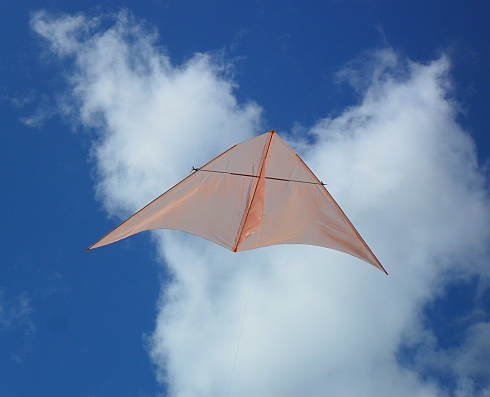- Home Page
- Flight Reports
- Sticked Deltas
MBK Delta Kite Stories
Featuring Sticked MBK Deltas
Every MBK delta kite is a pleasure to fly in conditions that suit it. In the larger sizes, deltas are also very convenient to set up, needing only a quick attachment of the spreader rod.
On this site, there's more kite-making info than you can poke a stick at. :-) Want to know the most convenient way of using it all?
The Big MBK E-book Bundle is a collection of downloads—printable PDF files which provide step-by-step instructions for many kites large and small.
That's every kite in every MBK series.
These kites respond very well to rising air and sometimes seem to be
sniffing it out as they meander left and right on the end of a long
line! In such air, they lean back and soar higher.
The Dowel Delta, in particular, has often amazed its owner by staying aloft when there seems to be almost no breeze at all at ground level!
Here's a short-format flight report featuring the Dowel Series kite:
Just 2 KPH Near the Ground
The sun was out, with high-altitude hooks of cirrus (mares' tails) sweeping the sky. The wind? There was barely a whisper most of the time. Just the occasional 4 or 5 kph gust came through from a nearby small thermal lifting off. This was perfect weather for the pale-orange MBK Dowel Delta kite!
 MBK Dowel Delta on a short line for the photo
MBK Dowel Delta on a short line for the photoThe launch was easy, by letting out line just fast enough to maintain a 45-degree line angle. Bravely, I decided to go with 20-pound line to get the absolute most out of the big but light-pulling delta. In these conditions, it's not the wind speed that tightens up the line the most, it's the vertical plumes of air that cause the kite to surge overhead from time to time.
After some pleasant flying around 200 feet or so, I let a thermal carry the kite almost vertically up to 400 feet. This was the legal limit.
Corresponding to the sorties overhead were other times when the delta would hang down at around 45 degrees, pulling hard but getting no higher in slowly sinking air.
A lazy loop would sometimes happen when the kite would get disturbed by a sudden drop in wind pressure and find itself pointed off to one side or even heading for the ground. Eventually, it was time to pack up, so I took about 15 minutes to get the kite down slowly, right into my hands.
A check of the Windtronic meter showed an average wind-strength of 1.9 kph and a peak gust to 5.3 kph.
If winds tend to be very light around your area, you'll love the Dowel Delta kite! Make one for this weekend.
Tim's Blog Posts
Featuring MBK Delta Kites
Since these are short-format reports, they are grouped together. The page links are in decreasing order of kite size:
MBK Delta Kite Posts—Multi-Dowel
Tim's Flight Reports
Featuring MBK Delta Kites
The links below are full-length reports recorded by me, each featuring an MBK delta kite of one type or another:
Modified, Good in Thermals (Multi-Dowel)
Dicing With Sudden Wind Increases and Cloud Suck (Dowel)
Trimmed Out and Flying High (Dowel)
Amazing Flight in Almost Zero Wind (Dowel)
Smooth Stiff Breeze Keeps Line Straight and Spars Bent! (Dowel)
Pinned to the Sunset at 350 feet (2-Skewer)
Almost Zero Wind, But Still Some Interesting Flying! (1-Skewer)
Testing Conditions, But a Great Little Flyer! (1-Skewer)
The story or stories above document actual flying experiences. My write-ups are definitely "warts and all," since things don't always go totally as planned. However, half the fun of kiting is anticipating the perfect flight. When it happens, it's magic!
As mentioned earlier, there's more kite-making info here than you can poke a stick at. :-)
Want to know the most convenient way of using it all?
The Big MBK E-book Bundle is a collection of downloads—printable PDF files which provide step-by-step instructions for many kites large and small.
That's every kite in every MBK series.
